Canon says lots coming in 2019! Lens strategy, the future of A.I. and more… Executive Q&A
posted Friday, April 5, 2019 at 7:24 AM EST

We had a chance recently to speak with four top executives from Canon's Image Communication Business Operations group, the division responsible for all of Canon's photographic products. I probed into Canon's focus on photography in the face of its expansion into many related businesses. Does their significant investment in areas like medical and industrial imaging mean less R&D dollars for photographic products like camera sensors and lenses, and is the relatively dated sensor deployed in the new EOS R and EOS RP a sign of that? We also talked lens strategy and what AI technology might mean for the future of cameras.
What we got back is interesting stuff as always; check it out, and join the conversation in the comments below!
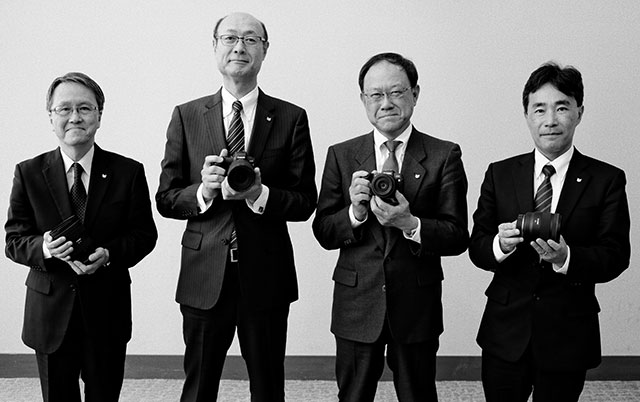
|
Naoya Kaneda |
Go Tokura |
Yoshiyuki Mizoguchi |
Manabu Kato |
Dave Etchells/Imaging Resource: We are actually asking many people this question, but the motivation for it came from Canon. Mitarai-san [Ed. Note: That's legendary Canon CEO Fuji Mitarai] said recently he expected the ILC market to decrease by half over the next two years. This seemed pessimistic to us, but was it a projection for the industry as a whole, or just for Canon's own ILC business?
Go Tokura/Canon: So <chuckles> our boss, Mitarai-san, is not just talking about the camera industry, but he's looking at Canon as a whole, the entire company. And so he has a very management perspective on this. And when you talked about that projection, it wasn't just about the market projection per se. He is looking at it in addition to the market risks that we need to expect in the future, and what that entails for us as a company and a portfolio, the impact that it may have. So it's not per se... [Ed. Note: The next few words were a little unclear; our interpretation is that Tokura-san was saying it wasn't so much a firm prediction, with sales ramping directly down.] It's a matter of looking at what can be in terms of the risks that we should expect to be prepared for.
Dave Etchells: Ah, hai, hai. Wakarimashita [Ed. Note: "Understood".]
Go Tokura: So when we look at it, we always look at the trend of what's going on in the market. But at the same time, because we have the top share in the industry, we need to be leading the industry. So we are confident about that. So that's [the reason or motivation behind] the R-series models that you're seeing in front of you at the moment [Ed. Note: Cameras and lenses were on the conference table], and also the lens launches that we have had. In other words, we're always working to project in advance what can be possible in this industry.
Dave Etchells: Ah, that makes sense: Mitarai-san is looking at risk management and considering what might happen worst-case, and thus where he needs to invest strategically to guard against that, as opposed to just making a straight market projection that he's trying to hit a specific number. [Ed. Note: See this comment by Thom Hogan on our Sony executive interview, for an explanation of how the market projections break down between ILC and compact cameras, with some educated guesses about DSLR vs mirrorless.]
Go Tokura: Exactly. Thank you.
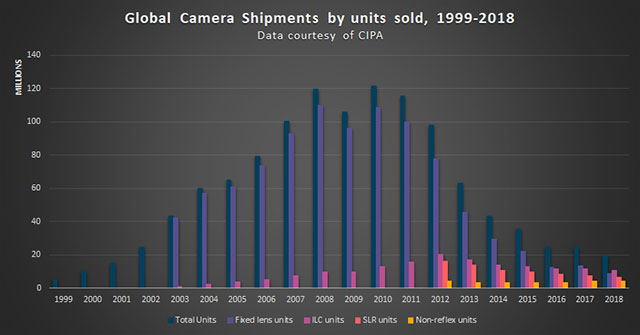
Dave Etchells: Following up on that then, Mitarai-san said that as a result of his anticipated contraction in ILC,Canon will direct more of its investment towards industrial and medical imaging. But I'm concerned that Canon has lagged its competitors in the mirrorless market, that you are new coming into the full-frame and especially that the professional mirrorless model is still in the future. Will Canon be able to catch up, given that it sounds like photographic imaging is going to be de-emphasized in R&D spending?
Go Tokura: So answering your points one by one, in terms of the development team or development policies, at the moment because we have just launched the RF-system and the new full-frame, our immediate judgement is to really expand on that new system series. So that's the first priority that we have. But the headquarters, how Canon as a whole uses our resources is obviously in terms of imaging technologies, we believe that there is a potential for industrial application in all sorts of areas. And in terms of our development team, we believe the technology that we develop will be the basis for such industrial application technology that gets it. And obviously resources we have under the team that would reset to focus on that area as well, but we have a role to play in that sort of development for the entire team at Canon. And so from that, I think as a whole we are comprehensively developing those technologies and working together.
Dave Etchells: So even if investment is focusing on other applications for imaging, the imaging group will be very well-supported because your technology is so important to so many different products?
Go Tokura: I won't be able to divulge any of the breakdown of the resources that we invest in. <chuckles> But Mitarai-san's intention is that in terms of the IOT [Ed. Note: IOT="Internet of Things"], we believe that there was always an aspect of the eye, the "looking at the image" aspect, and that will be an important part of that. Meaning that what we do as an imaging group is going to be a critical part of that as well.
Dave Etchells: One question I have is that while the imaging group's technology will drive and support these other areas, my sense is that the technology requirements in those areas are in many ways less sophisticated than what a professional camera needs. Requirements for very fast autofocus performance and things like that seem less applicable to me than in areas of industry or commercial application. So from that standpoint, will the requirements coming from other areas also provide the imaging group with the resources it needs to be able to develop things that are specific for the photographic market? I'm sorry, that was a very long question.
Go Tokura: <chuckles> No, no. Do you mean that in terms of having additional resources being attached to the imaging group?
Dave Etchells: My concern is that there's a lot of attention elsewhere than the imaging group, and that the requirements from other areas will drive development in directions other than what professional cameras need. So my concern is whether there will be sufficient support for the technology that's very specific to high-end photography. Does that make sense?
[Ed. Note: A lot of back and forth removed here; they initially weren't sure what I was asking. We pick up with a very condensed description of my concern.] ;-)
Dave Etchells: Yes. I'm just looking for assurance that there's going to be plenty of money for photography.
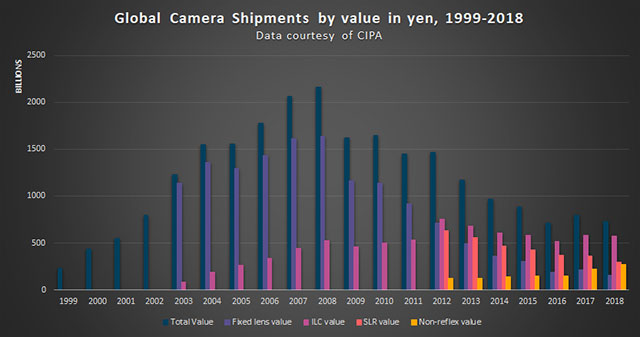
Go Tokura: So this B2B [Ed. Note: B2B = "Business to Business"] shift, as you could say, in our business strategy, this is actually part of our five-year plan that we already had in place before Mitarai-san even mentioned this comment earlier. So it has been in the works and we already have a B2B team organization in place working on this. So to simply answer your concern, no.
Dave Etchells: <laughs>
Go Tokura: Because the camera business will have the resources that we have had [in the past] and we will always maintain that part. So when we look at the development of our cameras, we always start with the sort of elements that we will develop and then that will get built into the product. So I guess you would call that the upstream part of it, and I think there's a long-flowing process that follows. We believe that in this aspect of the development, that is where we can jointly work with the B2B side of the organization so that we can actually apply our technology into this area.
Dave Etchells: Mmm, mmm... I think some of my concern about development and resources for photography comes from the sensor area and the fact that while the EOS Rs are wonderful cameras, they are still using the 5D Mark IV sensor. So it seems like a long time since we've seen a step in sensor development and I don't know the reason for that. I've speculated that maybe resources are being drawn elsewhere, so that's the source of my concern. And I think it's a concern that we've heard voiced from consumers as well.
Go Tokura: You have nothing to worry about.
Dave Etchells: <laughs>
Go Tokura: From 2019 onwards, we have streams of development going on, so you have nothing to worry about. We will be [leveling] up.
Dave Etchells: Good, good. Oh, that's great.
<laughter>
Dave Etchells: It's good that I can communicate that emphatic an answer back to our readers. I know you can never say what is coming or when, but if you can say so directly "nothing to worry about", I'll take that as a good sign.
<laughter>
Dave Etchells: I'll switch topics a little bit to lenses. The RF 50mm f/1.2 L is a phenomenal lens. We are *so* impressed with its image quality and it's so much more advanced and higher-quality than the existing EF 50mm f/1.2. How much of that improvement is due to the new lens mount and what that lets you do with the structure of the lens, and how much of it is just a matter of general advancements in optical technologies -- more extreme aspherics, better design software or whatever?
Manabu Kato/Canon: First of all, thank you for complimenting so wonderfully our lens!
<laughter>
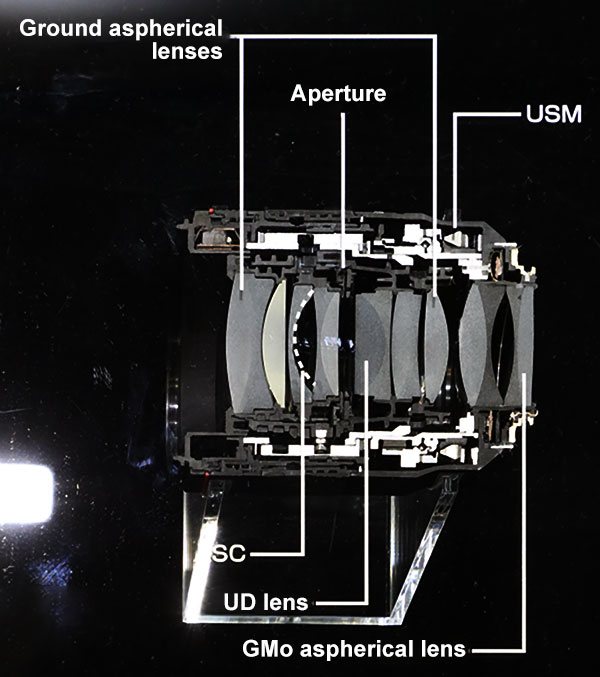
Manabu Kato: As you rightly pointed out, yes, this new mount really does play a great role in advancing image quality. And also the optical technology advancements that we have made over the decades have been accumulated in this lens. I actually mentioned about the new system when we visited you in Atlanta as well. The fact that we can put this large lens very close to the sensor allows for much more of a practical approach to this. It really does the job in terms of elevating the standard. So the optical evolution that we saw, if we compare with the EF lens and the material that's used to create this lens, half of that did not exist when we actually developed the EF lens in the past. So that's why it's using a new material that allows us to do it.
Dave Etchells: Oh, you mean, the optical glass itself is new?
Manabu Kato: Yes. [Ed. Note: A surprise to me; I didn't realize that there had been recent developments in optical glass characteristics.] And also the new optical coating as well. Again, that's another thing that we didn't have in the past and because of the decades of development, we are able to see this, and that's why we have less ghosting. That, again, is something that's contributing to the high image quality. So it is the combination of these various technologies and material advancements that we have seen that accumulated in this lens. It's difficult to say how much comes from where, it's just a breakdown. But we believe that as a whole package, it's the integration of these things that allows the lens to perform as it does.
Dave Etchells: Right. Yeah. I knew that coating technology has been a huge change in lens design, because it is so good at reducing reflections that you can now have many more elements without losing light or having flare and ghosting. That's been a change across the industry. Related to the new mounts themselves, though, just yesterday I was speaking with a lens designer from another company, and he explained to me that a key part of the mount and being able to move it back is the lens design can be more symmetrical and so easier to correct distortion. So desu neh? [Ed. Note: So desu neh, pronounced "so des neh" means loosely "That's true, no?"]
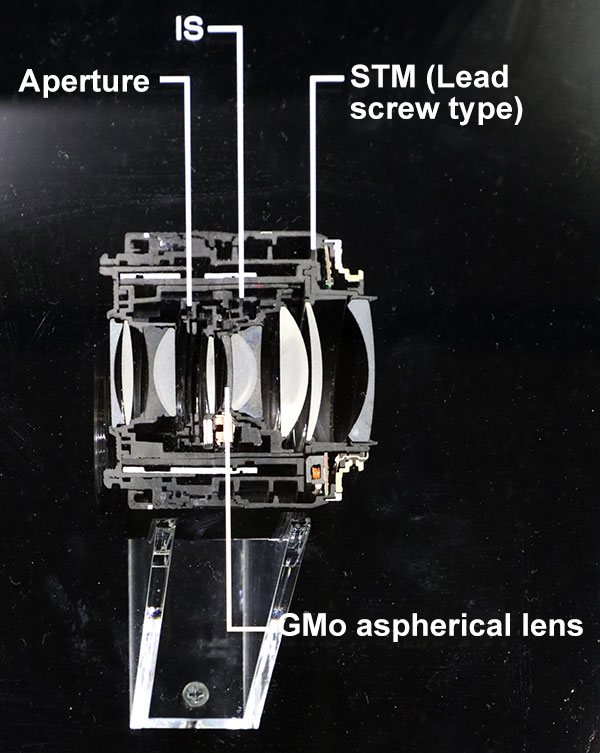
Manabu Kato: The question is that the [basic structure of the] lens, is it symmetrical?
Dave Etchells: Yes, symmetrical. The old-style narrow mount, especially for wide-angle lenses, the front element will be huge, and then taper down and be small at the mount. But with a wider mount, the rear element can become bigger. So with the wider mount, the back element can become larger and the front element smaller, and he explained to me that this helps reduce aberrations; it makes it easier to correct aberrations. Is that the case?
Manabu Kato: I am going to try to [explain] this. <chuckles> The large diameter mount actually allows for the [optical center of the] lens to be placed right in the middle, as you said, symmetrically between the front and the focus area, which allows for more optical possibilities. Does that make sense? It's the aperture is centered...
Dave Etchells: Oh, so, it means the aperture is in the center of the lens, optically? Oh, interesting. That's maybe more what "symmetrical" means, that you can have the aperture in the middle, and then roughly similar elements on both sides? Ah, interesting!
Manabu Kato: The point of the symmetrical design literally was to reduce the aberration, so that's why we were able to achieve that with this.
[Ed. Note: This was very interesting to me, and seems like one of the fundamental differences between prior DSLR lens mounts and wider mirrorless mounts with shallower back-focus distances. Being able to have larger rear elements close to the sensor not only lets you reduce the size of the front elements, but the ability to basically mirror the optical structure on either side of the lens diaphragm makes it much easier to correct things like chromatic aberration.
Canon and Nikon have both strongly emphasized their new mounts, saying that they'd lead to higher-spec lens designs, but it initially wasn't clear why this would be the case. This reply and the earlier one from our Nikon executive/technical interview at CP+2019 shed light on how larger/shorter lens mounts help optical design.]
Dave Etchells: Let's switch to camera bodies. The Canon EOS RP was just announced and has a very aggressive price; very impressive! In the U.S, through the end of March, they're bundling the body with the extension grip and the mount adapter for US$1299, a very good price. We're curious, how has the RP been received by the market so far? Have initial orders fallen short, met or exceeded your pre-launch projections?
Yoshiyuki Mizoguchi/Canon: First of all, we're still [in very early stages] so we won't be able to comment on that, but in terms of the feedback we have had from sales and also online, we have had really good responses and they're very favorable. And we are seeing this worldwide, not just in particular areas. This is probably in response to its small size and light weight, and the competitive pricing.
Dave Etchells: Mmm, mmm.
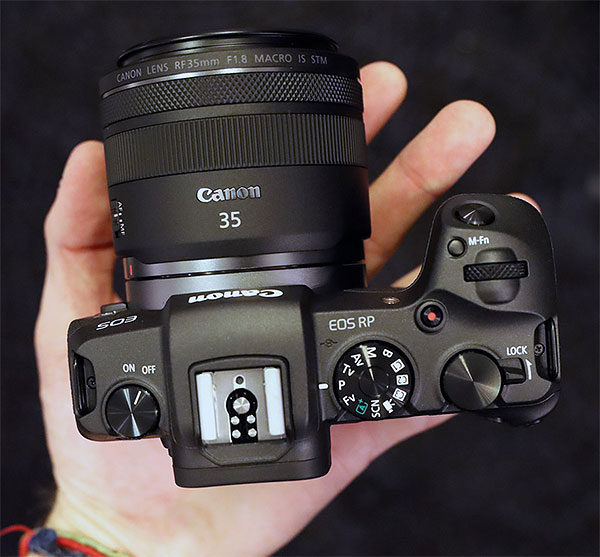
Yoshiyuki Mizoguchi: But at the same time, we haven't forsaken any article of the performance that it can provide and the high functionality. And also, the ease of operation. I think that as a package, that seems to be a very attractive offering and we're getting positive responses because of that. The initial intent in development of the EOS RP is that we wanted to really capture the users who are [upgrading] to an ILC camera for the first time, and also people who are moving up from APS-C to full-frame. The intention was those targets, and the responses that we're getting so far, it's tells us that we did the right thing. We are getting that response that we were looking for.
Dave Etchells: Yes, yes.
Yoshiyuki Mizoguchi: Having said that, because we're still not at the launch stage per se, we can't give you any figures, but we have high expectations for our RP and because of that and with the responses that we're getting so far, I think we we are getting that response that we were looking for. So fingers crossed.
Dave Etchells: Yeah, we've been surprised by how much attention it's getting on our site with our readers. Maybe I shouldn't say surprised, because I shot with it in New Orleans, and it's just a lot of fun to shoot with. It's a very appealing camera to use, and the price point is extremely good too. So I'm not surprised. I'm glad to hear that it is doing so well for you.
Yoshiyuki Mizoguchi: Thank you for that.
Dave Etchells: I have a question about the strategy of launching the Canon EOS R first, and then the RP coming some months later. We're curious why it was that you didn't launch the two of them together, like Nikon did with the Z6 and Z7. They had to ramp up production, so the Z6 shipped later, but that was very different than your strategy to launch the EOS R and then the RP several months later. What led to that decision, what was behind that strategy?
Yoshiyuki Mizoguchi: It's not so much a strategic decision that we made that there were a few months in between. It was more of an internal matter that we had to resolve. Because of that, we did have different launching times, but we wanted to actually leverage that to our advantage. In other words, we have this great new EOS R system, and when we launched it, people really got excited about it, and then got their excitement again "Wow, again, RP!". This is a whole new system, so we want to really get all of the attention, if you will. So we were able to capitalize on that sort of time difference.

Dave Etchells: You got two separate hits of attention, yes.
<remark in Japanese, followed by laughter>
Yoshiyuki Mizoguchi: And we have a role to play in CP+, where we have to really motivate the excitement [for the show]. <grins>
Dave Etchells: Hah, you need to give people something to come to CP+ to see, neh? [Ed. Note: "neh" = "Right?"] <laughs> But also you said "internal issues too. Obviously, you had to ramp up production on two different products so I'm sure that was part of the issue, as well?
Yoshiyuki Mizoguchi: That's actually not a huge issue...
Dave Etchells: Not a huge issue. Hmm... [Ed. Note: Interesting that it wasn't an issue of ramping production for two models at once. My sense in the interview, though, was that they didn't care to go into the actual, internal reason for the staggered introduction, so I changed the subject...] Relative to the development of new lenses, you've announced a wide range of RF lenses already, including many fast primes, fast zooms, and then more all-purpose lenses. But obviously the catalog of EF lenses is enormous. And it will take a long time for the RF system to catch up and fill out. How much of a role do you see the EF-to-EOS R mount adapter playing in day-to-day use of the R series? And do you have any statistics on how many EF lenses the typical EOS R or RP buyer already owns?
Naoya Kaneda: We do have the statistics, but we won't be able to disclose that with you unfortunately. But with the EF lens and with the adapter of course, it allows for the EOS R to be able to tap into the EF-series, and the EOS R system actually brings out the potential of those lenses. In other words, the autofocus. And so that's why it does really advance or optimize the EF lens within the EOS R camera system. And with the adapter, it also has the control ring and a filter. So by having these features, it actually allows the user to appreciate more of what EF lenses can do, going beyond what they have appreciated in the past for EF lenses. [Ed. Note: It's interesting that they pointed to more-capable autofocus as a benefit of using EF lenses with EOS-R cameras. High-end DSLRs like the EOS 1Dx Mark II have significantly better subject-tracking performance in difficult situations like sports shooting, but then mirrorless cameras have the ability to integrate image data into the AF algorithms, as we see with the widespread implementation of face-detect and eye-detect AF.]
Dave Etchells: Mmm.
Naoya Kaneda: So yes, we don't look at it so much as "Okay, EF lenses have so many [models], RF lenses have so few", it's a matter of looking at the entire system, and we are looking at how it can provide the best value for the users. We believe in the lenses and the adapters, and we're happy to see that many R-system owners are using the new RF lenses. So we think that [we are] satisfying the needs of these users.

Dave Etchells: So to the extent that people are comfortable in using EF lenses with R-series cameras, does that mean that some common or popular lenses like a 24-70mm f/2.8, will be a lower priority for you to develop? So what you will do is focus more on unusual lenses that you couldn't do on EF-mount, like a very high quality 50mm or 28-70mm with very large aperture? The short version of the question is: Given that people use EF lenses so much, will that change your development direction for RF-mount lenses?
Naoya Kaneda: In terms of the RF-mount with its large diameter short and flange back, I think really, for us it's about taking the EF lenses that we already have, and being able to provide more opportunity, greater photographic opportunity for the users. At the end of the day, we are always looking at what we can provide for the users' requirements. So we have been pursuing that, that is one of the priorities that we are looking at. But at the same time, when we look at the lenses that you see in front of you [Ed. Note: Referring to the range of lenses spread in front of us on the conference table] the zoom lenses, these are a core part of our system. In other words, they are really at the heart of it. And so we've always wanted to bring these type of lenses out to market as soon as possible. That's the development that we are working on as we speak. And the 35mm lens that we have, and a 24-240 lens which is about to come in the future, both of these lenses are not for professionals, but for amateurs. So with all these lenses in the lineup, we believe that we are able to [develop] lenses from Canon to offer to a wide variety of users in a wide variety of applications, and that will not change.
[Ed. Note: At a US retail price of just $499, the RF 35mm f/1.8 lens is indeed a very much more consumer-oriented optic. It's interesting that Kaneda-san pointed to a 24-240mm model that's apparently coming in the near term, as another consumer-oriented design. Depending on its bulk and cost, that would make a great "vacation zoom" for EOS-RP users. Meanwhile, Canon underscored the importance of traditional f/2.8 zooms in their RF-mount strategy.]
Canon PR: I'd say we have five minutes.
Dave Etchells: Oh, five minutes. Okay, let me skip down and ask... We're seeing artificial intelligence enter photography in many different ways, from autofocus to post-processing features. Where does Canon stand on AI, and what are some ways that you can see it changing photography this year and beyond?
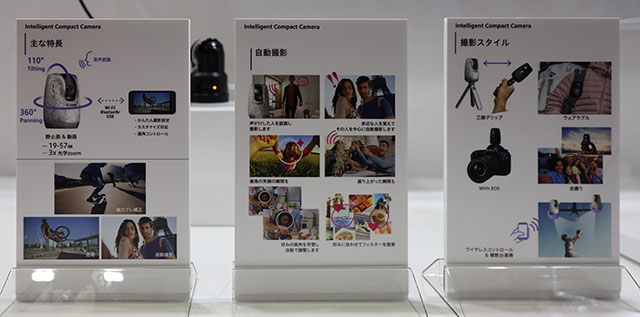
Yoshiyuki Mizoguchi: AI is one of the key technologies, I believe, that's out there at the moment, and we have development in place to deploy AI into our entire camera systems. Because Canon is bold about looking at the evolution of what cameras can do, we will always look at the possibility of how AI can contribute, provide help or advance that evolution of Canon cameras. So AI, I believe, has a role to play in terms of the imaging. I guess [subject] detection is one of the key things that it can provide and there's a way to apply that. Facial recognition, for example, or eye recognition. Those are the technologies that you might see out there, and we believe expanding that field of AI applications is something that we will look into. What we can do in terms of the pre-shooting and post-processing, etc. We always look at [making] the best camera that can be [made], so that is something that we will look into. And that's how we will deploy AI.
Dave Etchells: So, AI is obviously part of your plans, but we can't discuss really details of what it will do?
Yoshiyuki Mizoguchi: <laughs>
Go Tokura: Unfortunately yes, we aren't able to. So there are some of concept cameras you will see in the booth downstairs. The intelligent compact camera is precisely that. It actually has an AI capability built in. In other words, you don't need somebody to actually push the shutter. It actually captures the images by itself. In other words, for us, introducing AI technology into conservative photography is one [thing we can do]. We also think there's a different way to apply the AI in terms of imaging capturing.
Dave Etchells: Hai, hai, automatic cameras, yes. I have joked that cameras will get so smart, that I will be able to just send my camera on vacation for me, and it will bring back all the pictures!
<much laughter>
Go Tokura: By drone?
Dave Etchells: Yeah, maybe by, drone. I can sit back at home with a drink and say "Ahhhh".
<more laughter>
Go Tokura: We hope so!
Dave Etchells: Oh, I see we're out of time now, domo arigatou gozaimasu [Ed. Note: "Thank you very much"] for your time!
Go Tokura: Thank you, too.
Summary
My main takeaway from this discussion was that Canon will continue investing in photographic technology, saying that imaging is fundamental to everything that they do, and that we should therefore expect to see significant developments in the photo arena over the next period of time. I have been concerned -- as have others -- by what it meant that the EOS-R and EOS-RP were built around the sensor from the EOS 5D Mark IV, a camera that's now nore than two-and-a-half years old. Without giving specifics, they did note that they had a lot in the pipeline for 2019, so it sounds like we can expect to see a lot more from Canon before the end of the year. Hopefully that will include a new-generation full-frame sensor, possibly even the full-professional mirrorless body they've promised will be coming at some point, although of course, they didn't hint directly at that this time around.
We also discussed lens strategy, and I was pleased to hear that they'll be developing a traditional set of f/2.8 zooms (presumably covering ranges lke 14-24, 24-70 and 70-200mm). While the 28-70mm f/2 covers part of that focal length range, it's a bulky and heavy special-purpose lens and lacks IS, so there's still a need for a conventional 24-70mm f/2.8. Also coming soon will be a 24-240mm "vacation zoom", aimed at and priced for consumers. This should make a good companion to the EOS RP for many entry-level users, and we'll look forward to testing that one for you once available.
Finally, we discussed AI and what it means for the future of photography. Here, they talked about subject recognition, and pointed to a somewhat unconventional proof-of-concept of an automated, "intelligent" camera, a prototype of which was on display on the show floor. I shot a brief video of it in operation, but the environment and particular circumstances were less than ideal for showing off its capabilities. The situation while I was filming was mainly one person (the PR staff member) talking, explaining about the system to me, and so it didn't show off the device's intelligent subject-identification and following capabilities very well. (Before I started filming, it was doing a much better job with two main speakers, effectively switching back and forth between the speakers fairly well, sometimes zooming out to get both in the frame at once.
I don't know that many of IR's readers are looking for a camera to take over photography for them, but I do think that this points to one direction in which we'll see personal imaging evolving significantly over time.